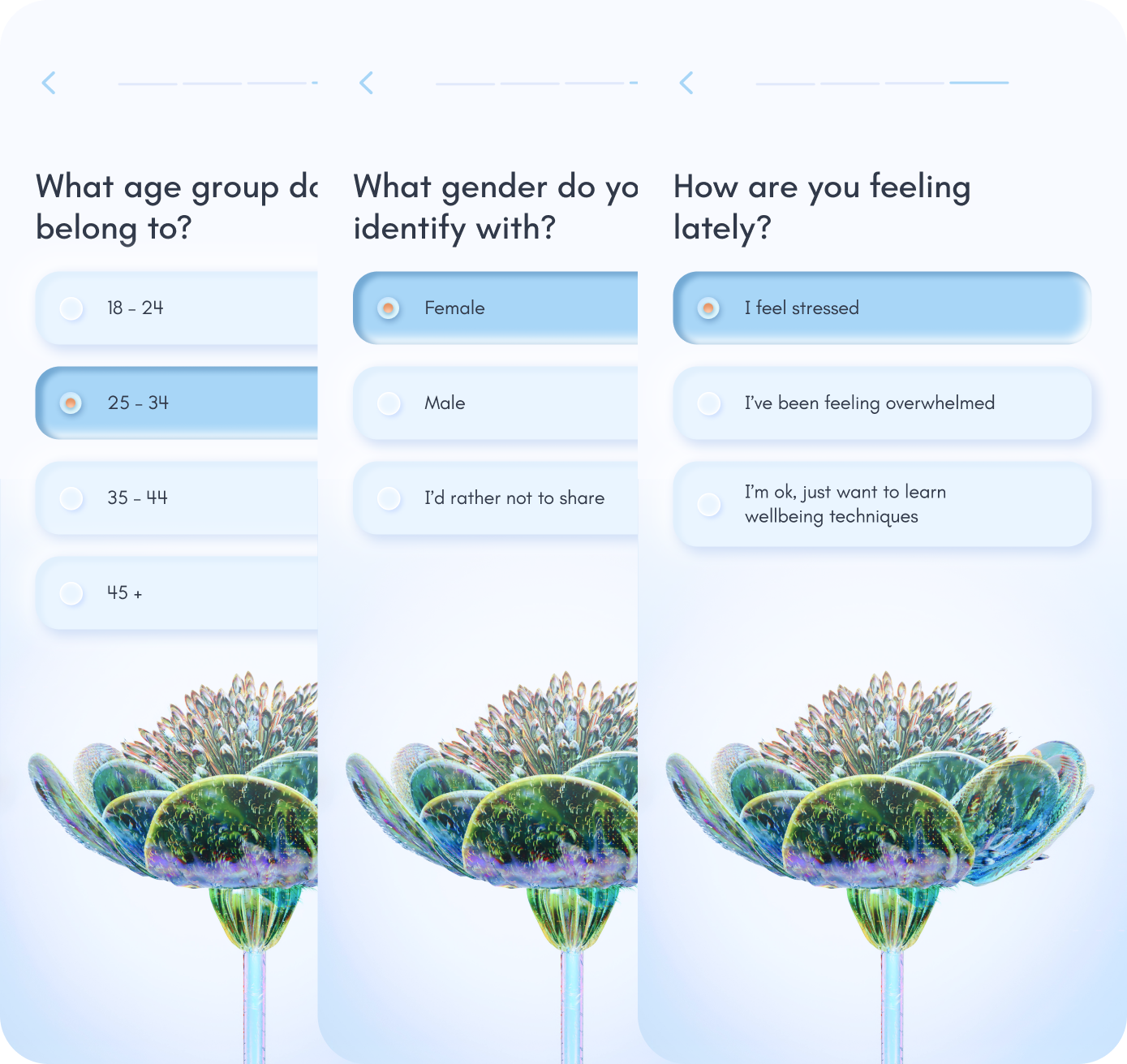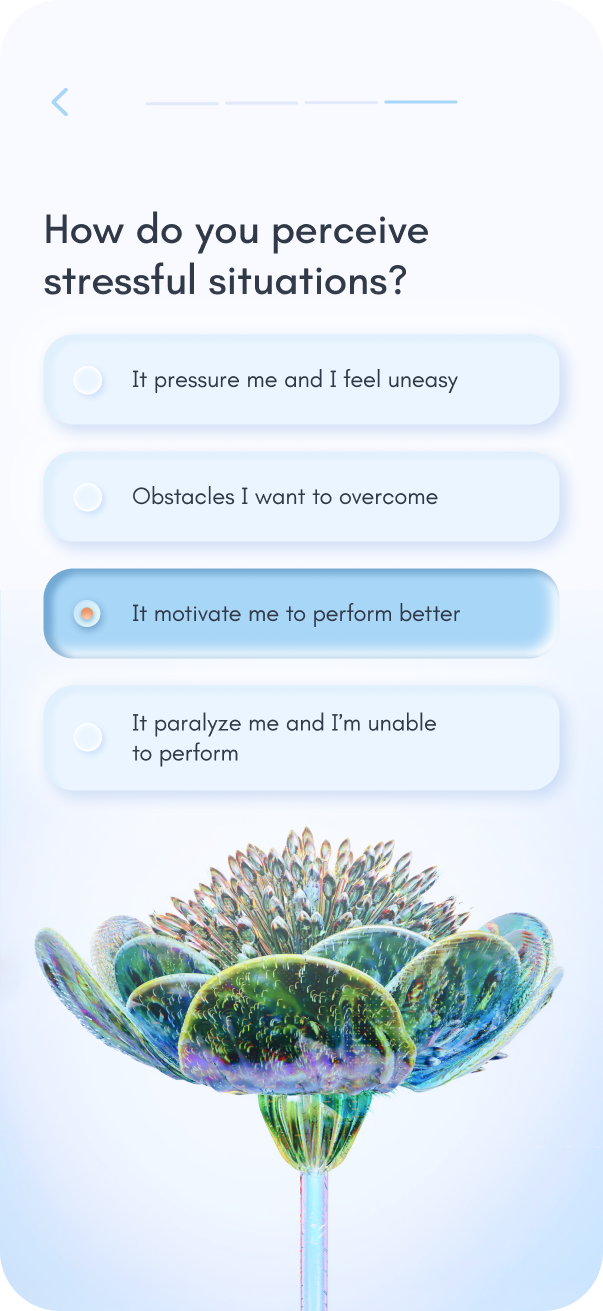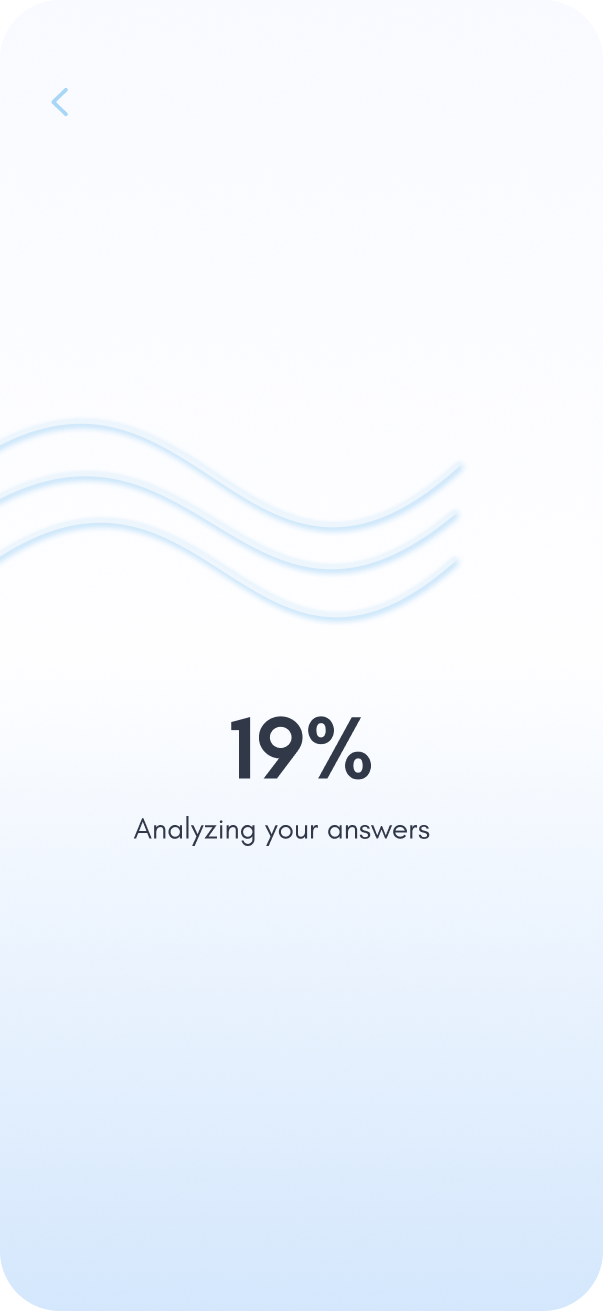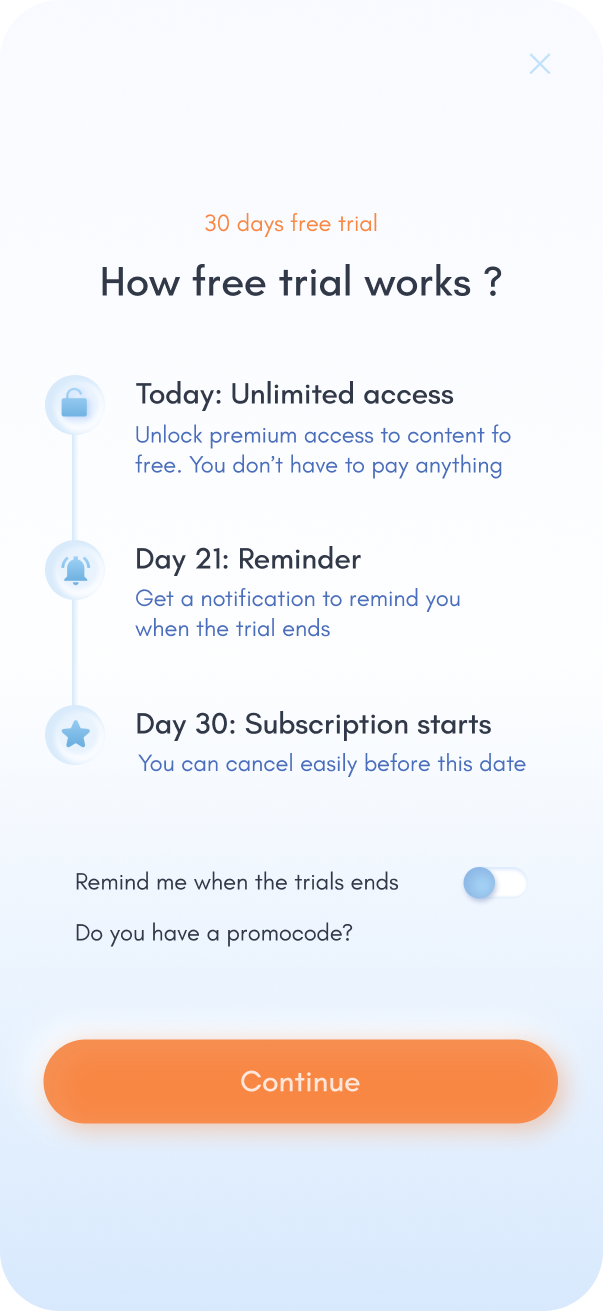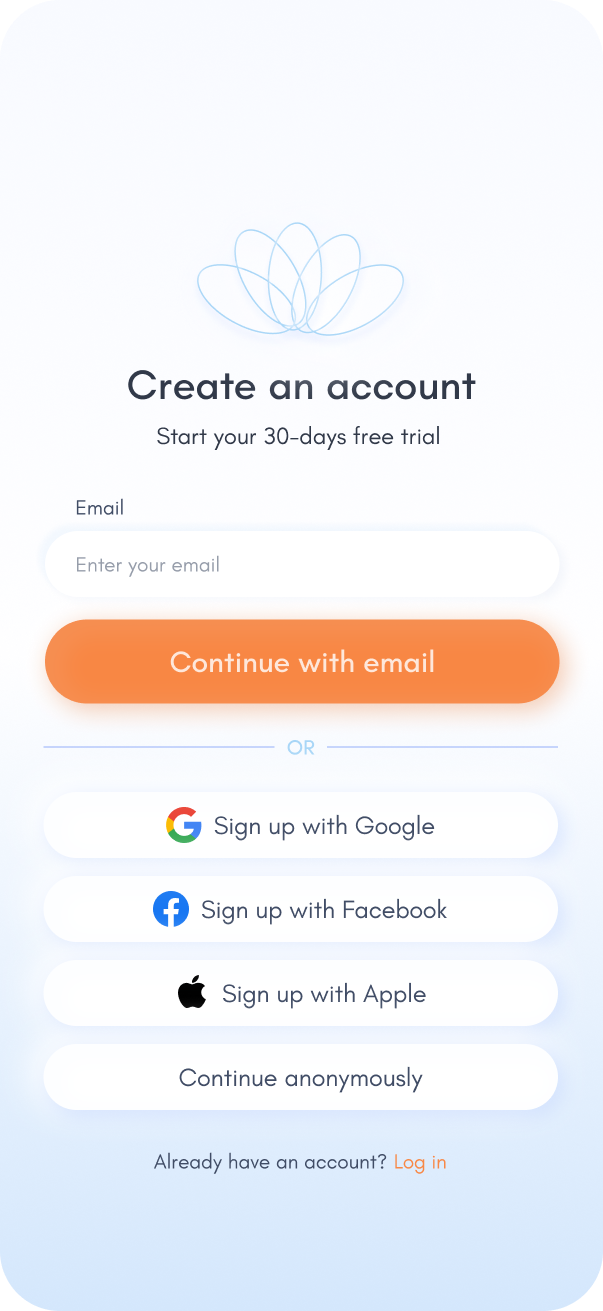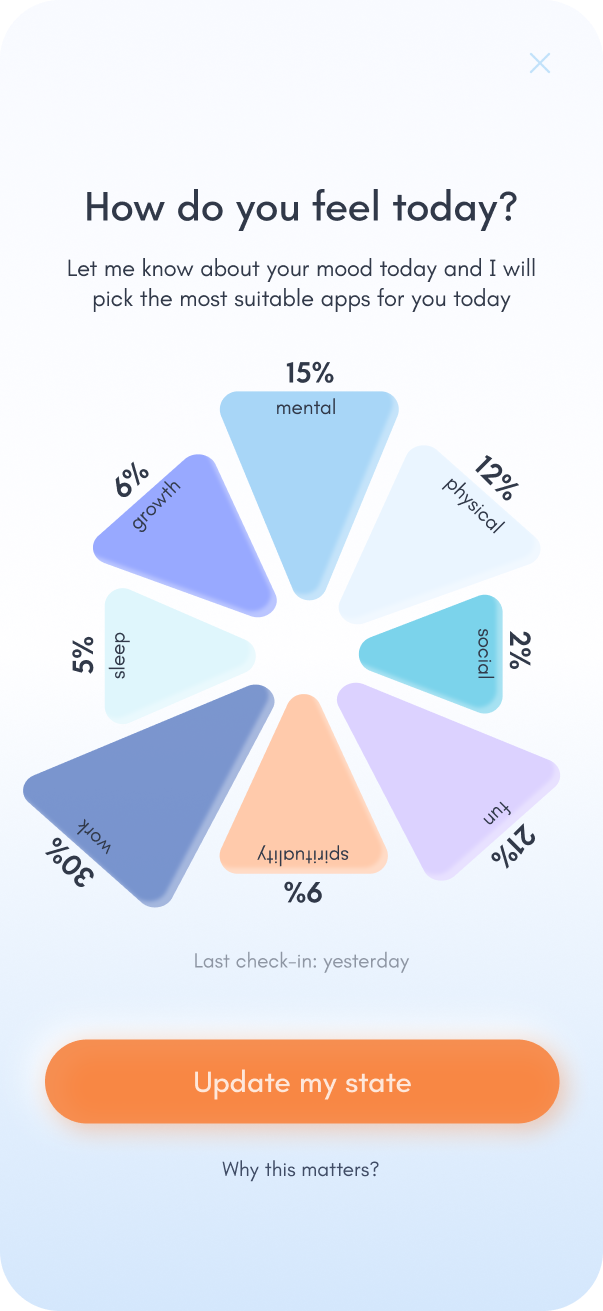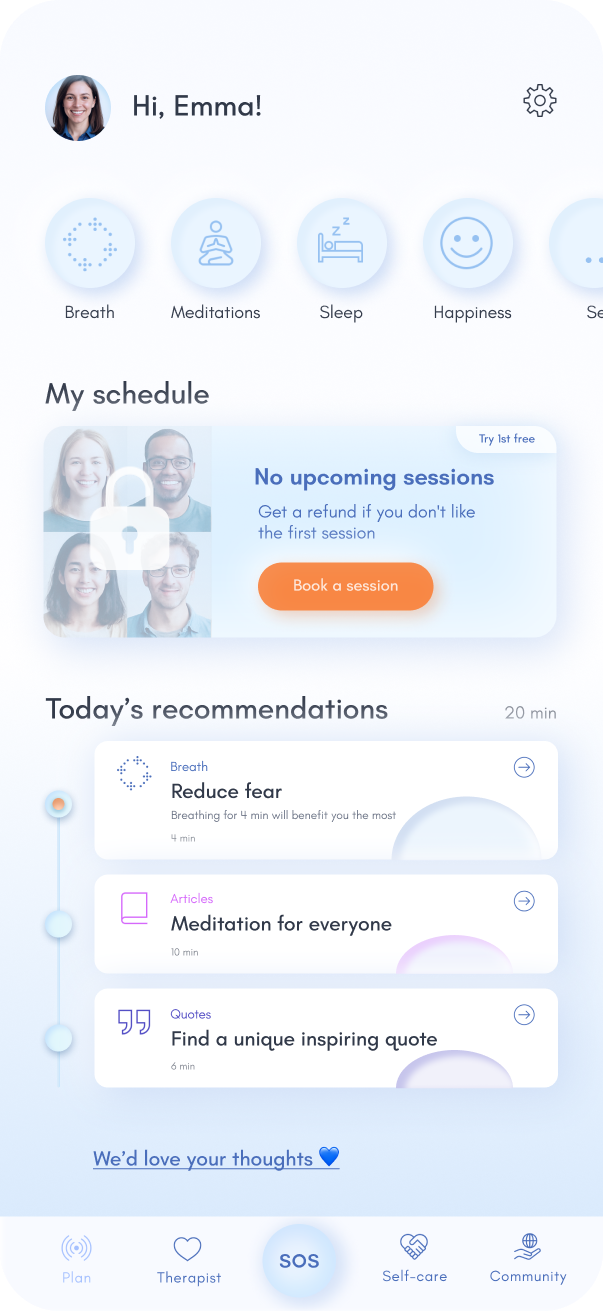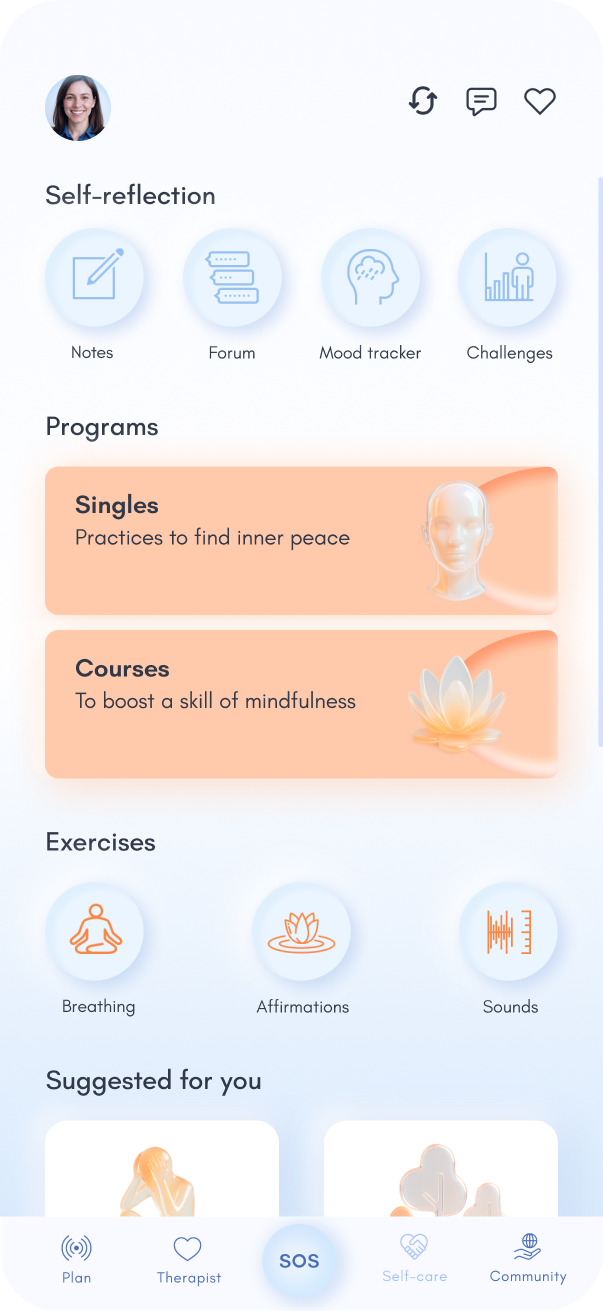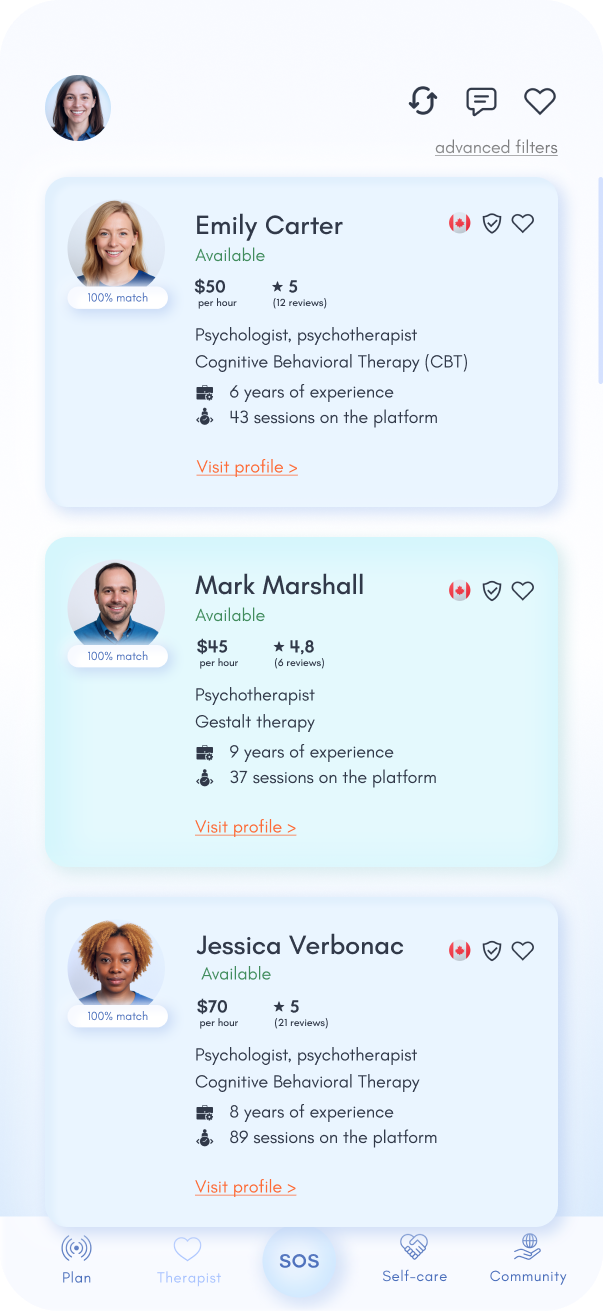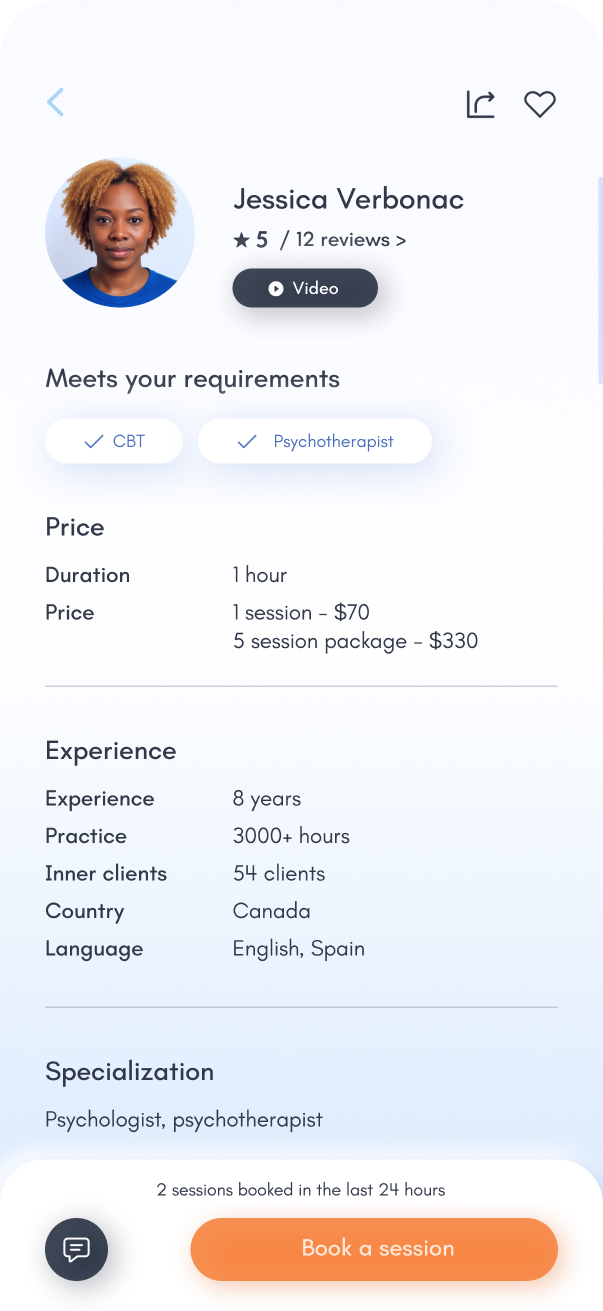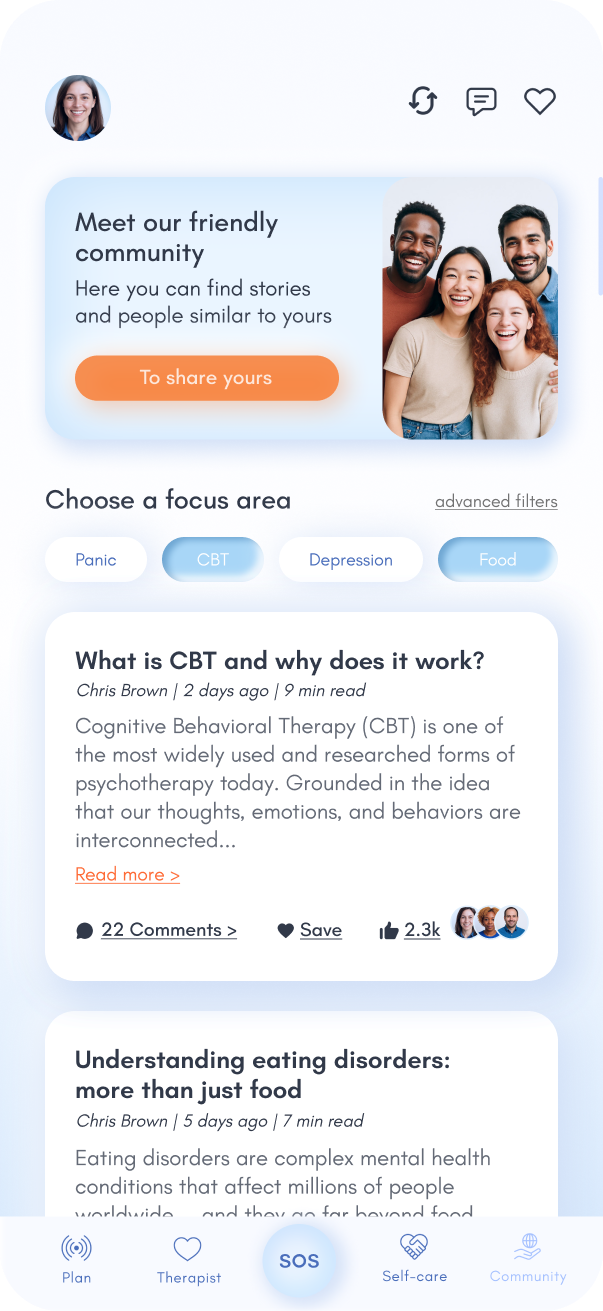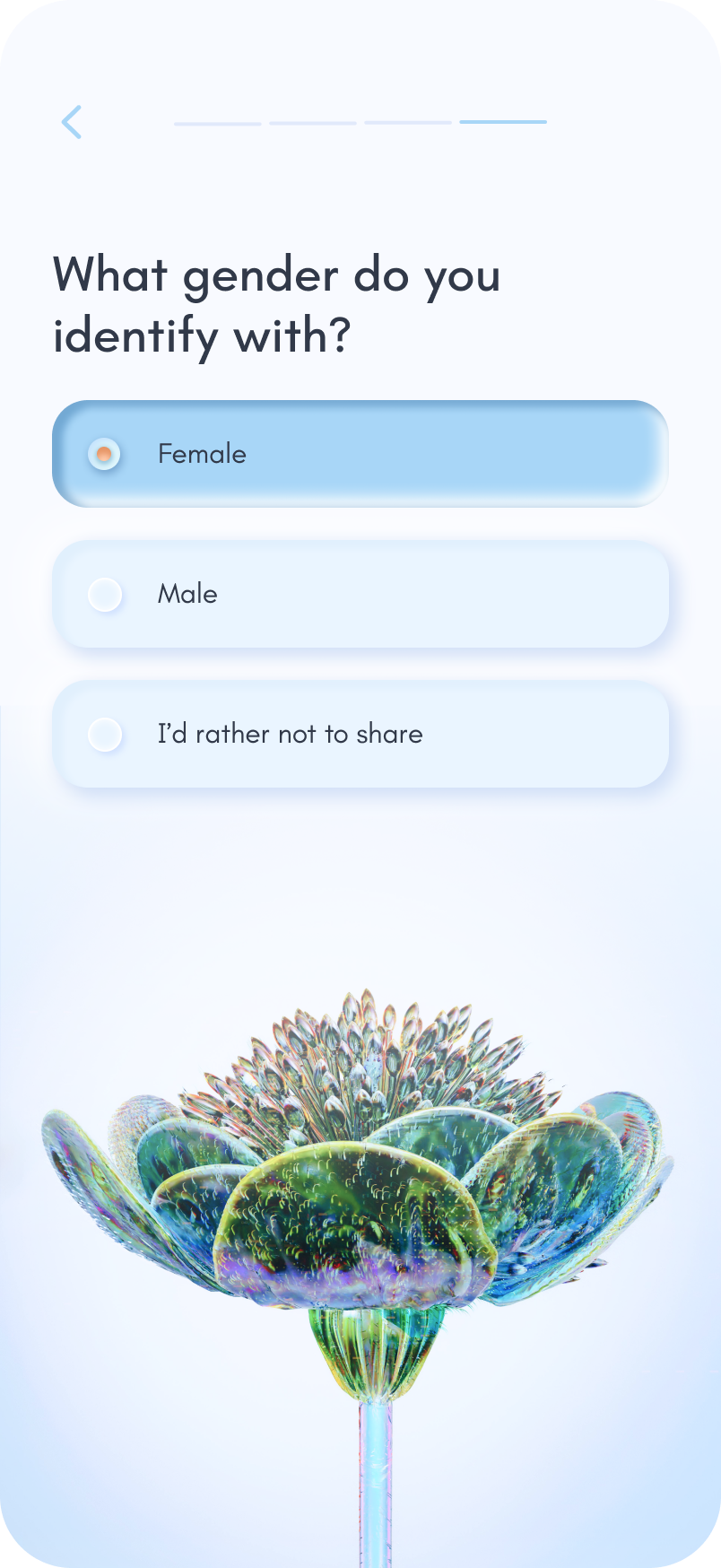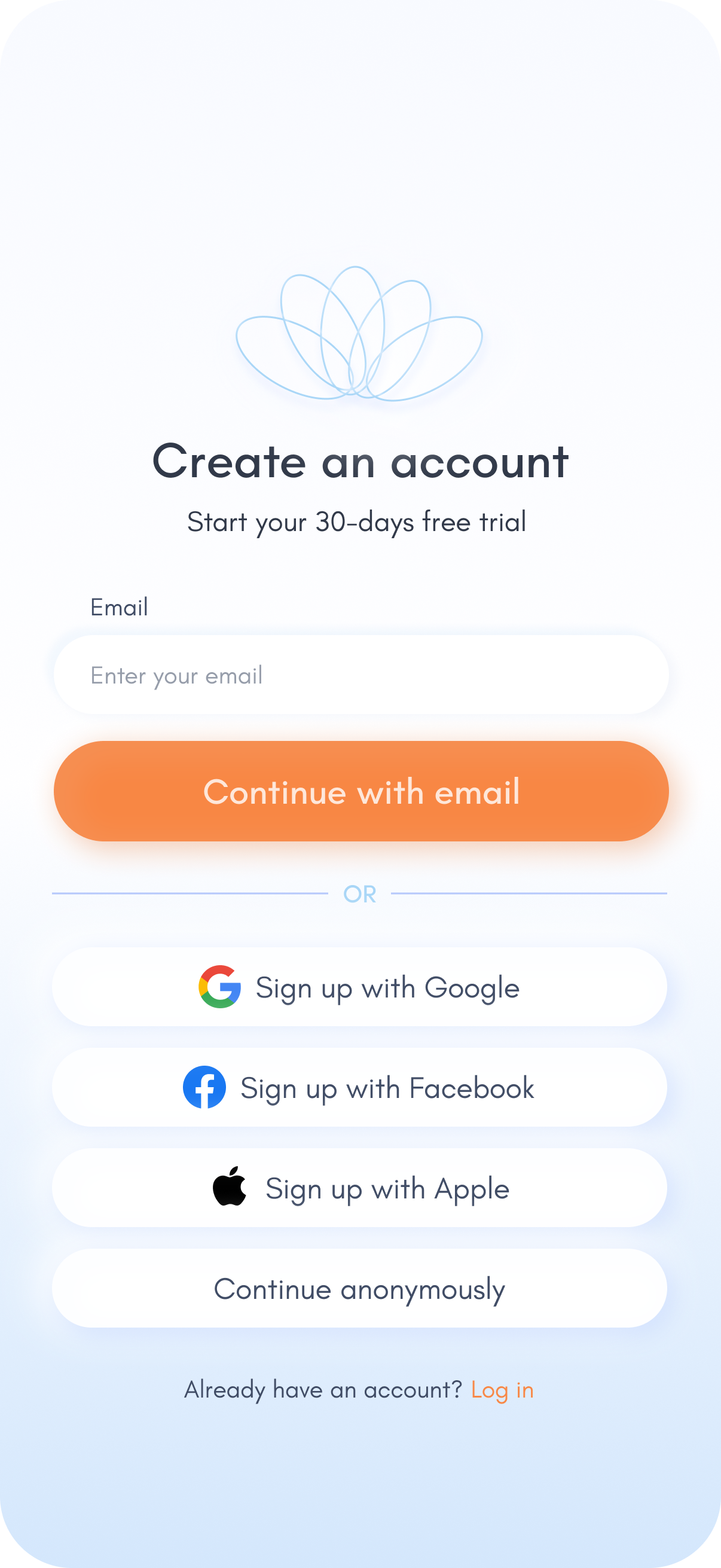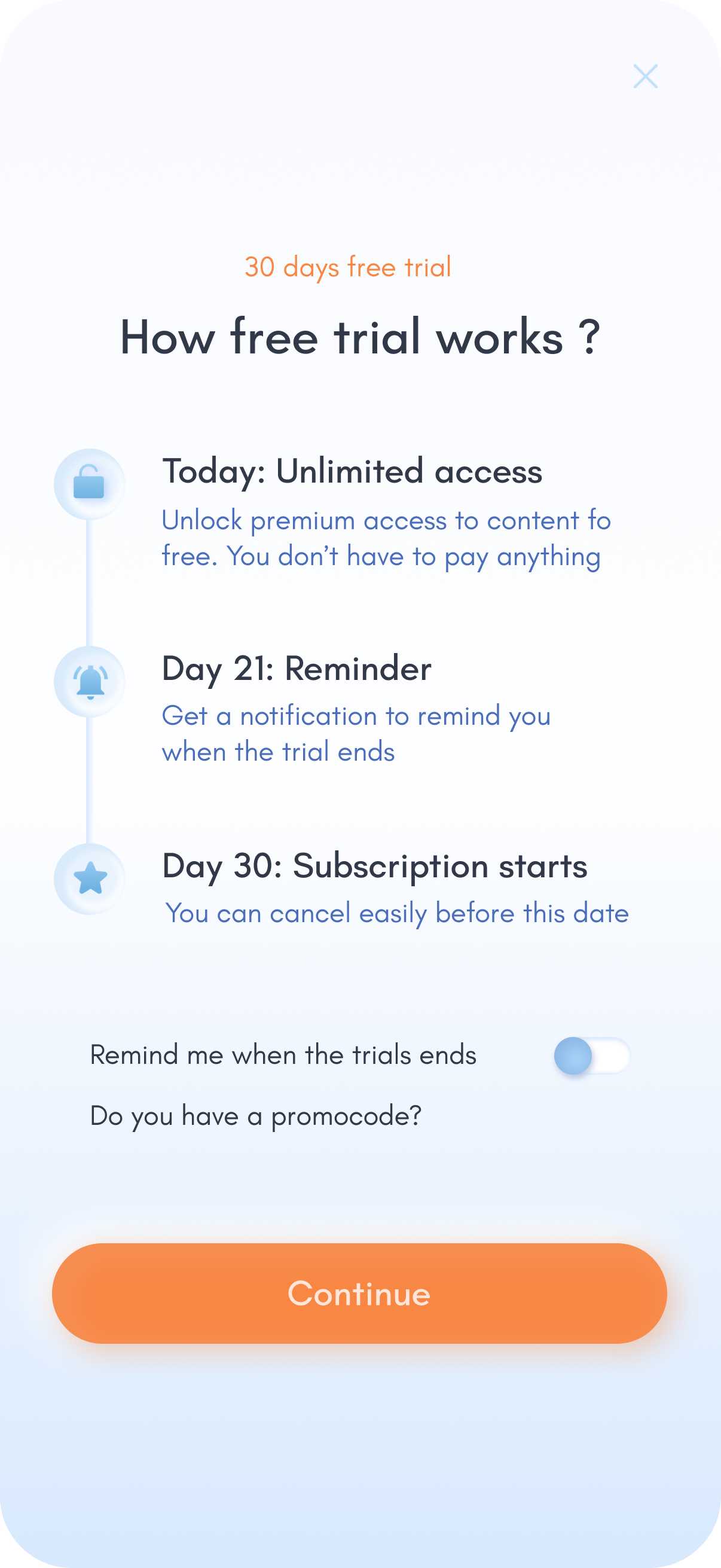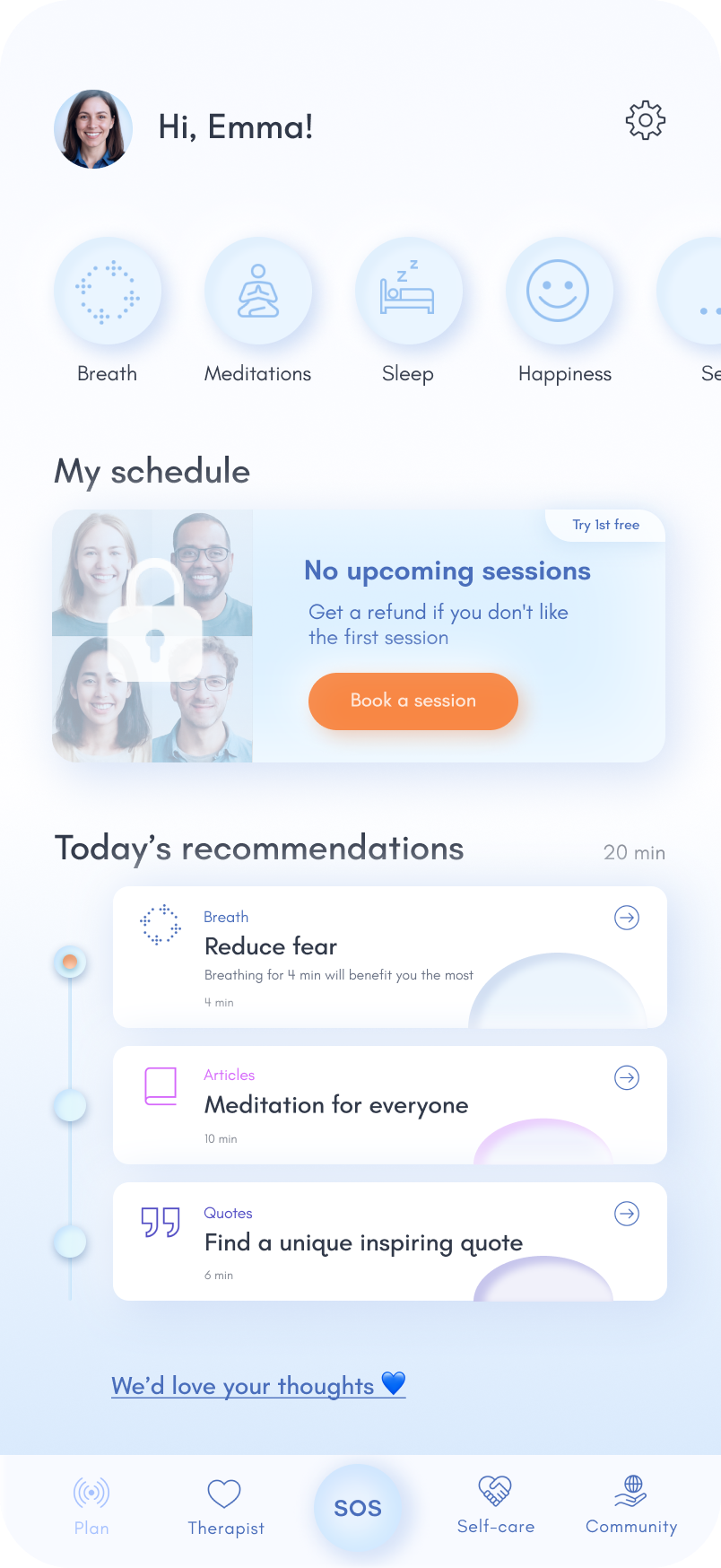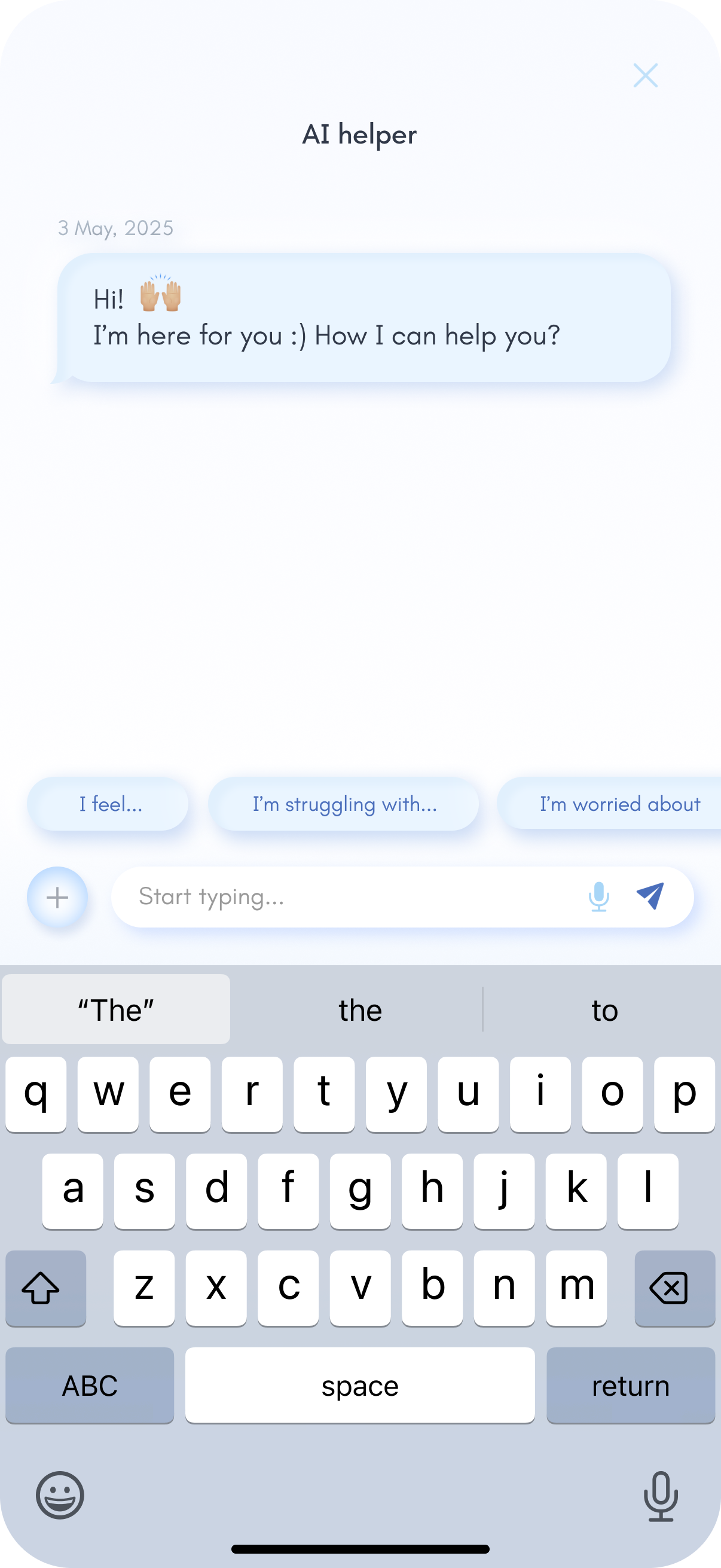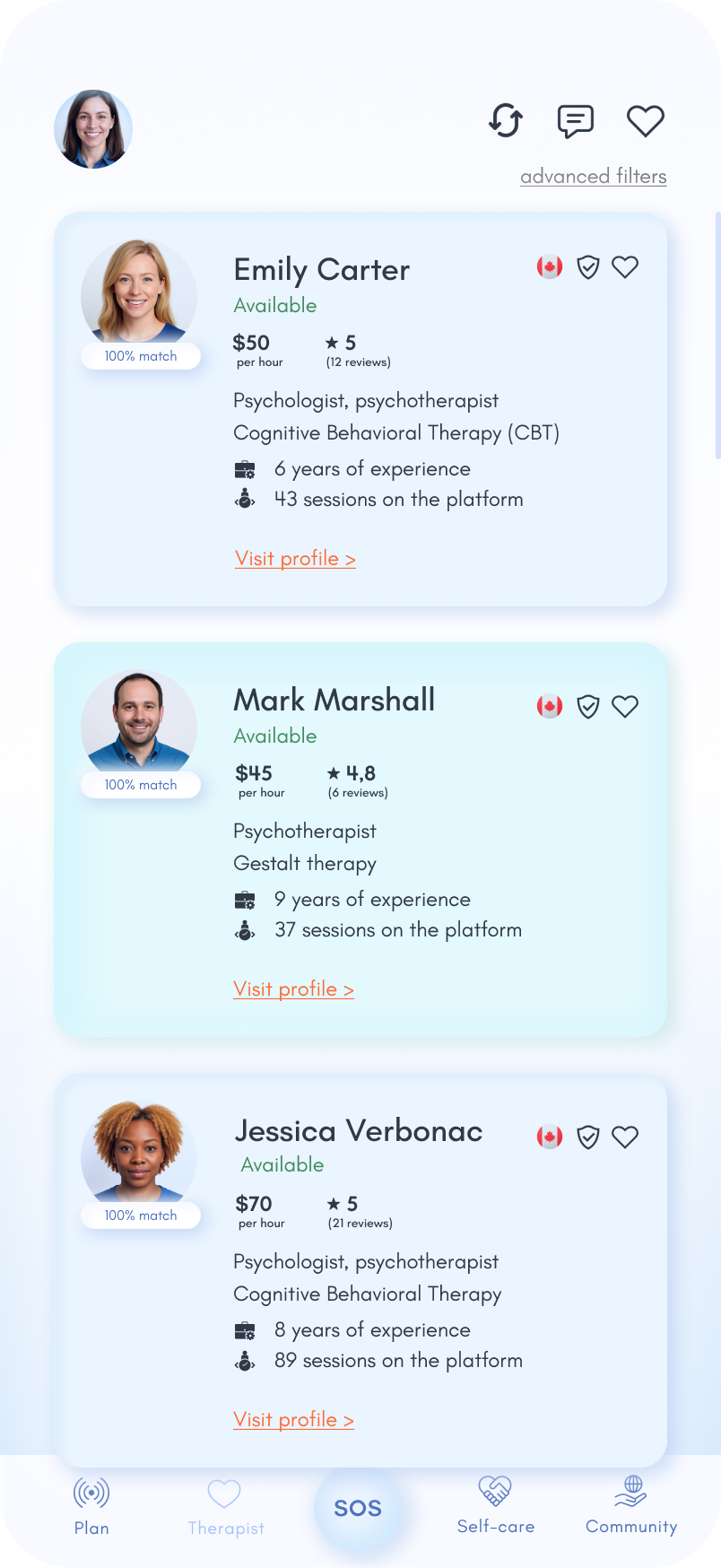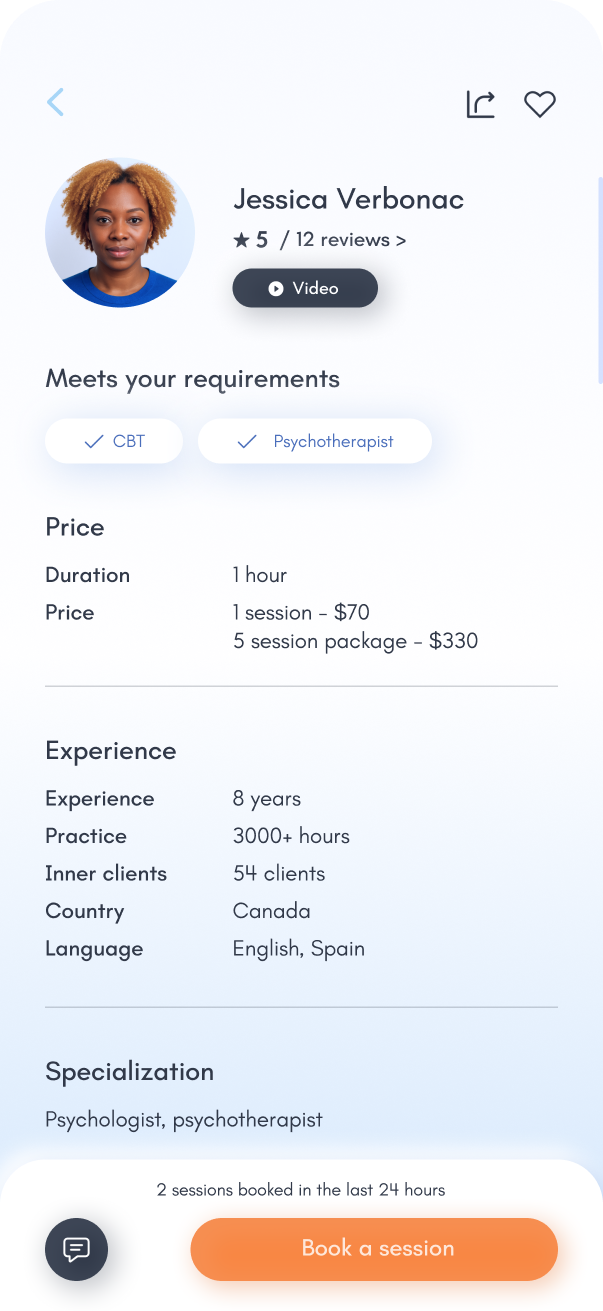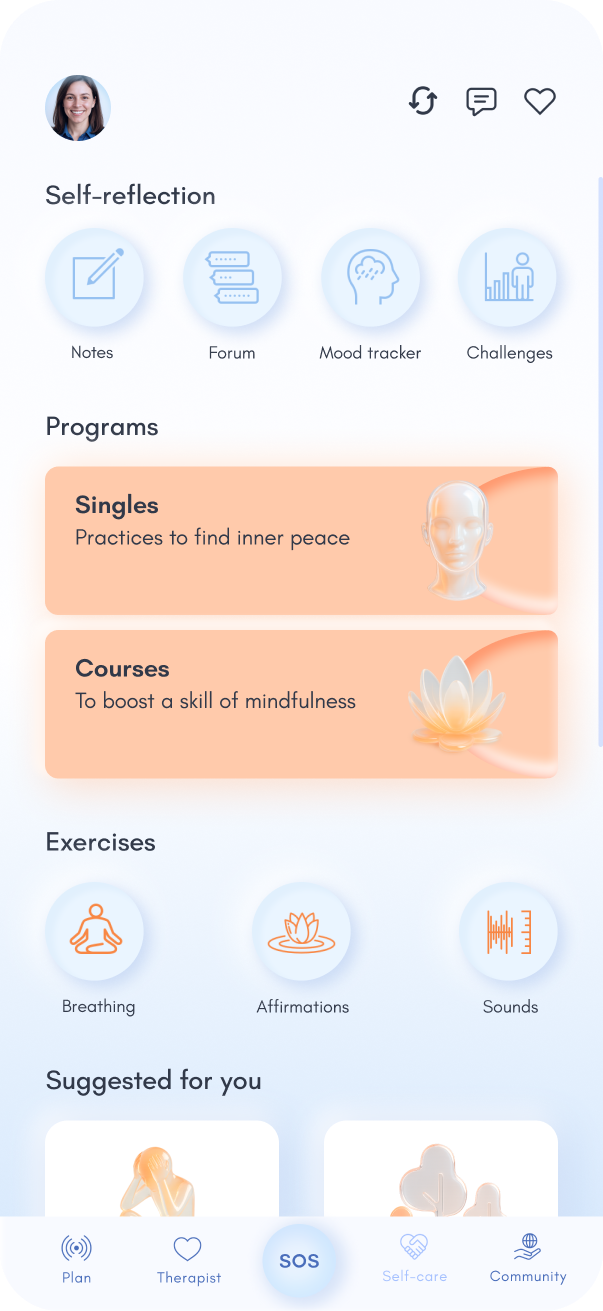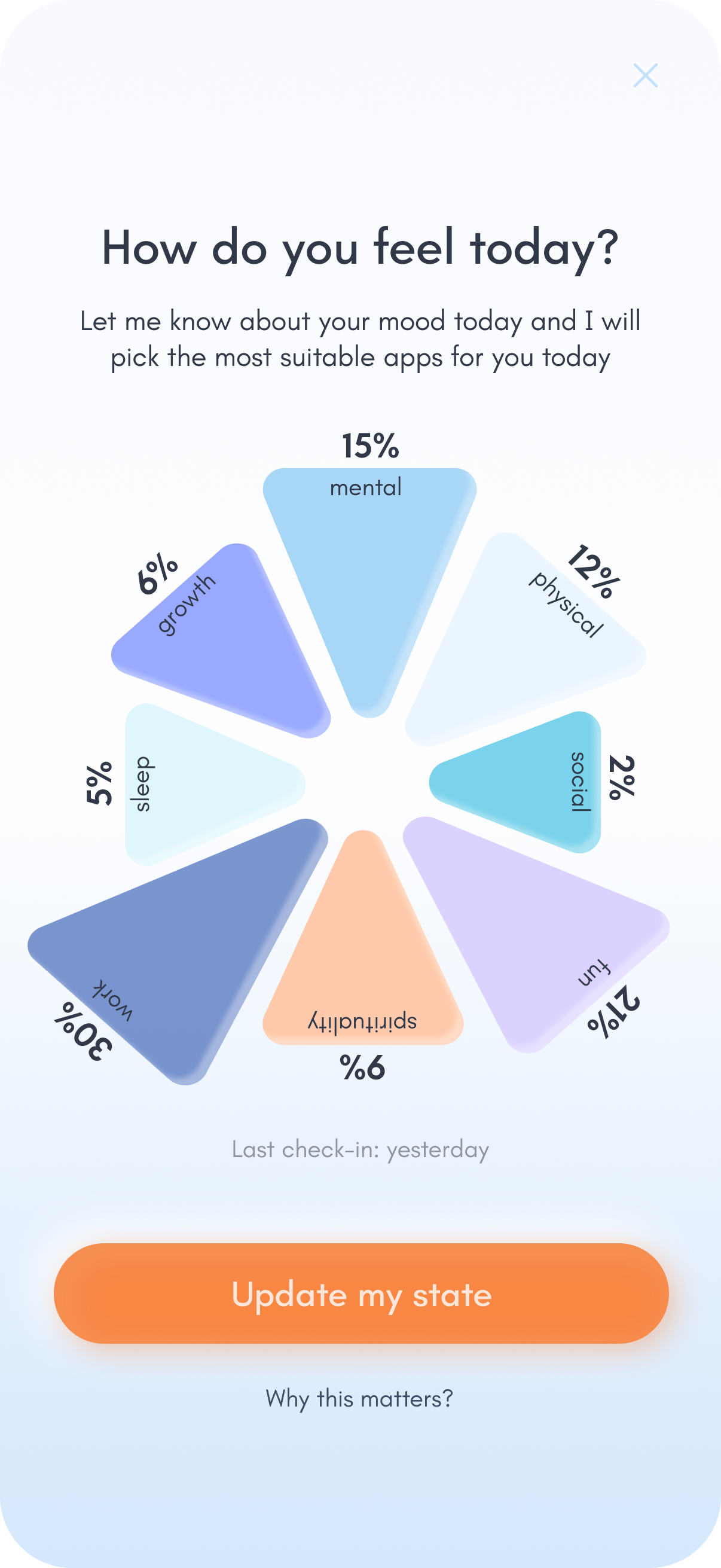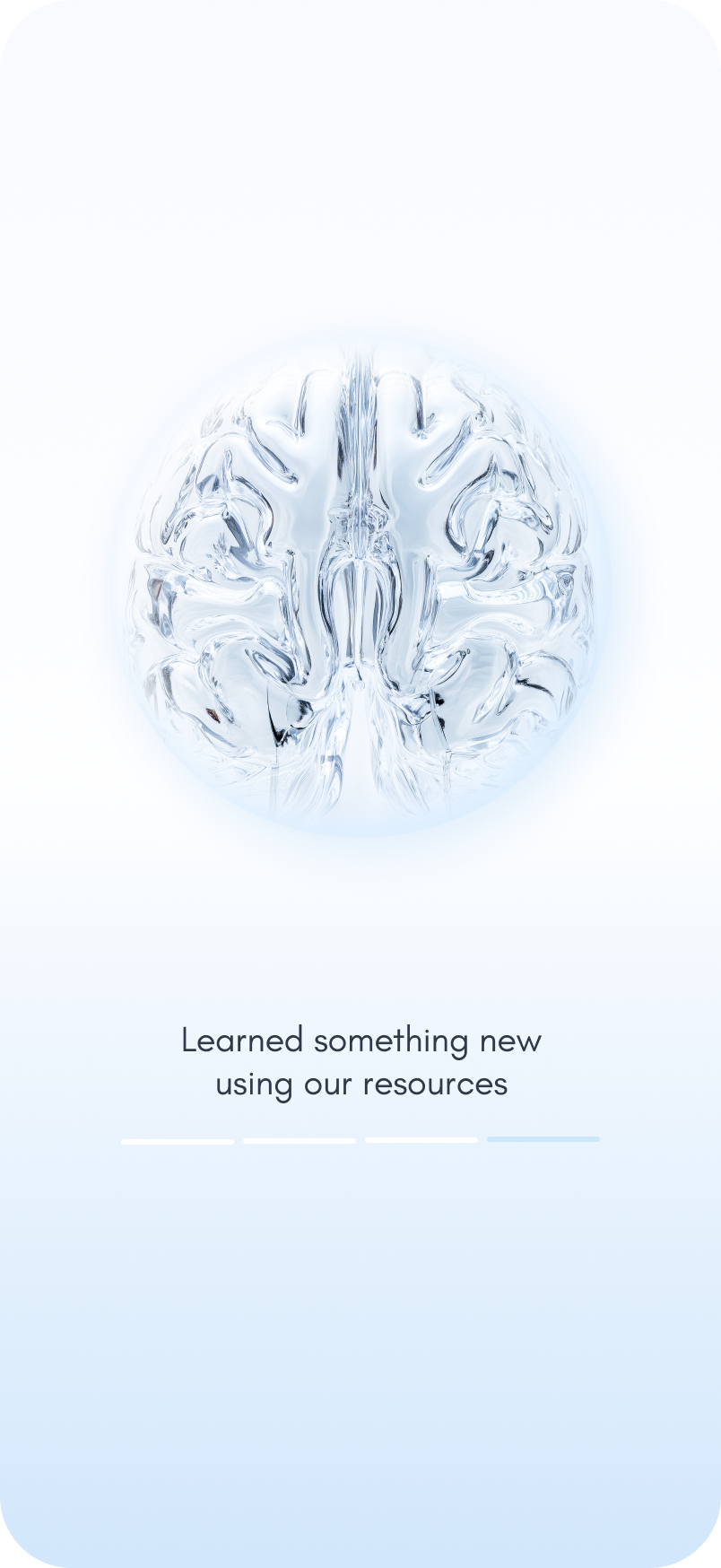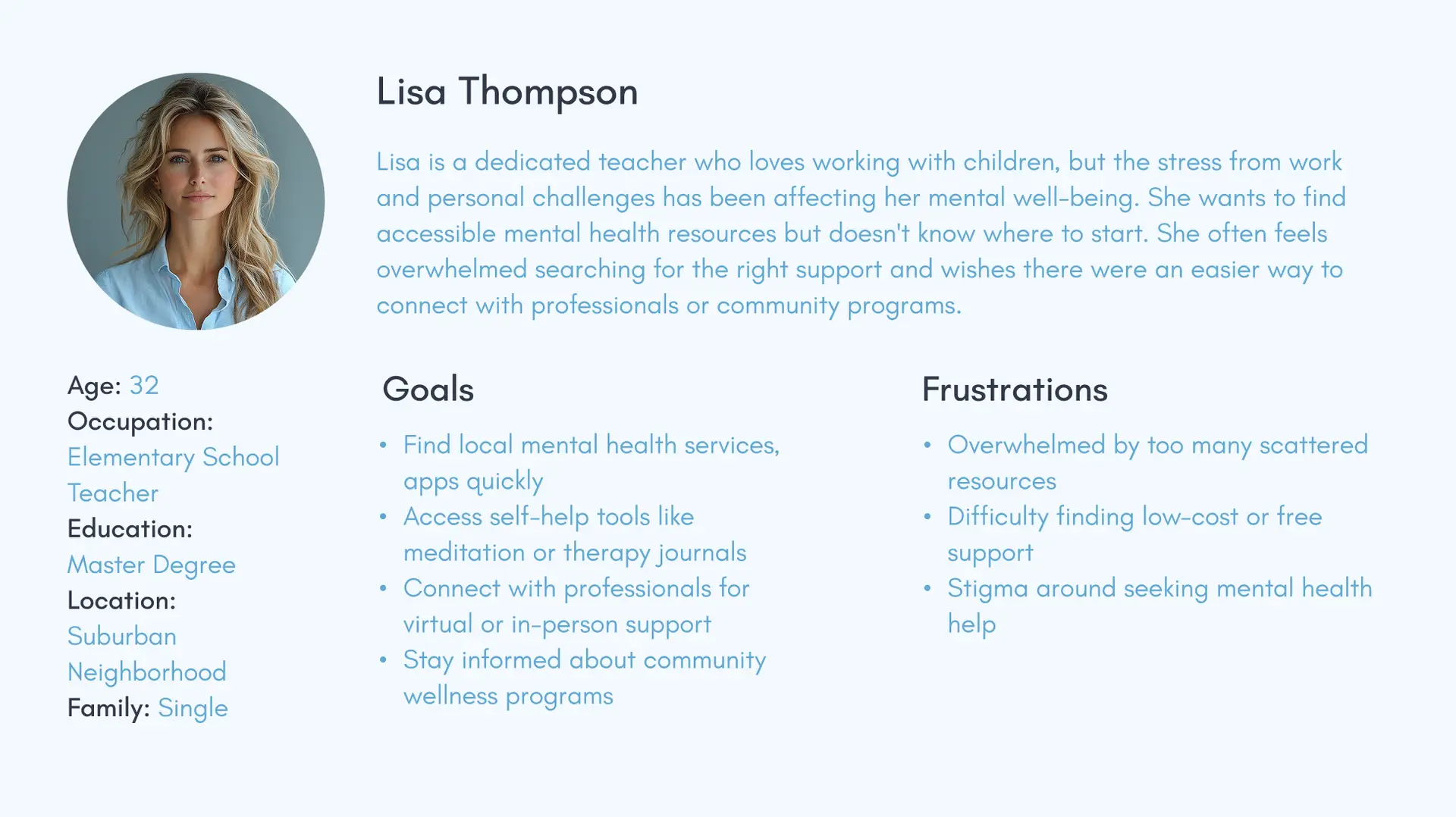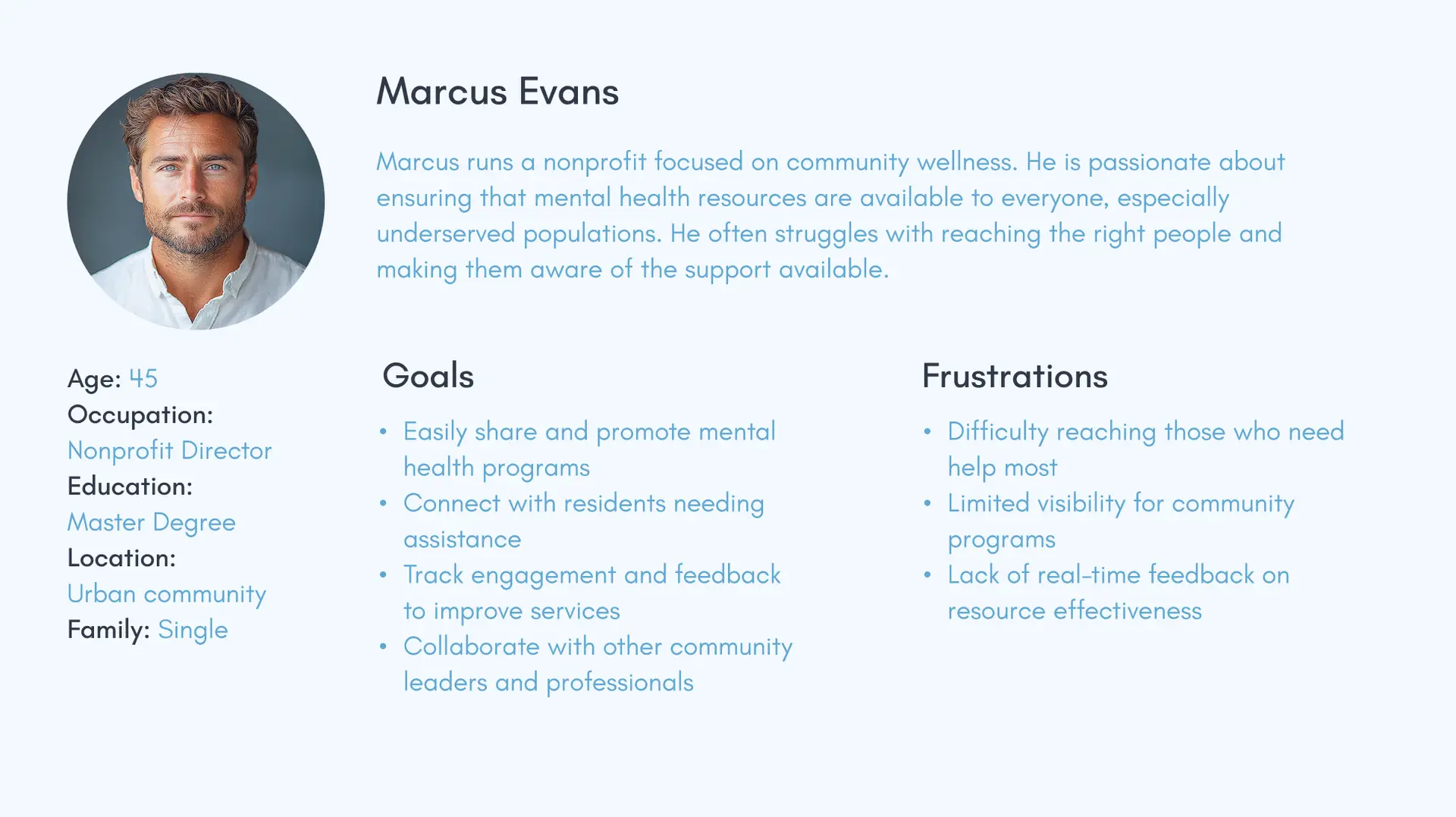UI/UX design | mobile app
inner: a mental health-focused mobile app
expertise
UX/UI Design
methods
Design Thinking,
Human-Centered Design
Tools
Figma, Miro,
Relume AI
duration
4 months
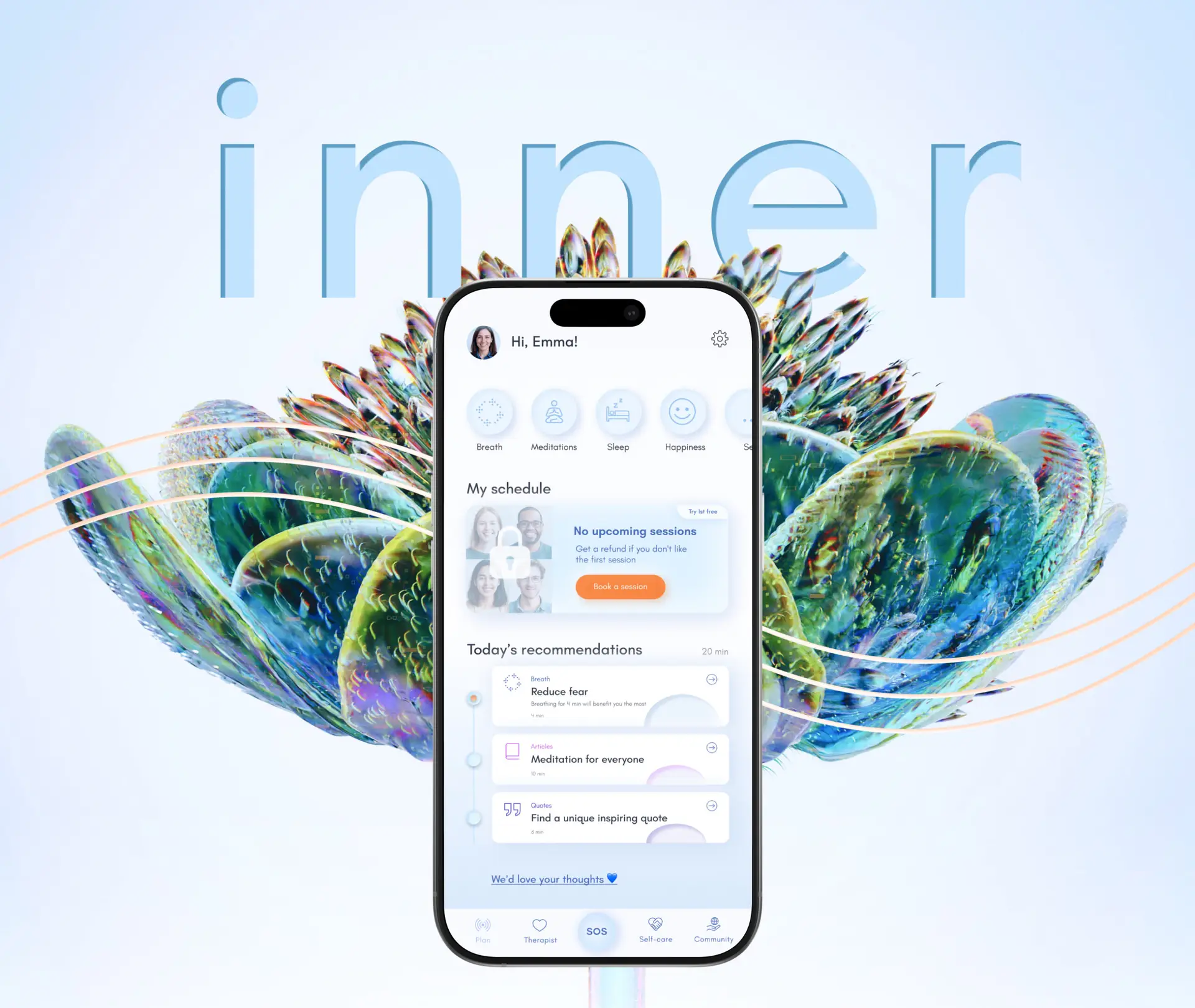
What is the project about?
Reason:
The last years many Ukrainians and people of different nationalities began to face serious problems of instability, mental health problems that required urgent attention. Feelings of helplessness became more and more widespread. I also fell into this crisis. When all the apps that I downloaded didn’t fully cover my needs, I decided to create my own mental assistant on my pocket, which would always be at hand. And I began research to help many people.
Challenge:
Anxiety, stress, panic attacks, are now an everyday experience for many. The main task was not to burden people with a distracting interface, functions, but to give a choice of the path to healing. Since mental health is an internal process – to create a design that is light, visually internal and soft. A great choice and at the same time a design challenge – neomorphism.
Solution:
I’ve developed this project with a clear mission: to support mental well-being through intuitive simplicity, accessibility for everyone.
The mobile app offers three main solutions:
01
awareness and education
The app develops users on the topic of mental health through a lively forum, where you can read people’s stories, share yours and understand that you are not alone, that what they are going through is common. It also provides an opportunity to prove yourself to professionals through participation in forums and raise awareness among the population.
02
self-support tools,
AI-emergency helper
The app contains guided exercises such as breathing techniques, meditations, state notes that users can refer to at any time if they want to cope with the condition on their own, as well as first aid for cases when they are unable to choose the necessary techniques.
03
work with therapists
The app allows you to choose the best specialist for you based on your criteria and start psychotherapy right in the app.
Design process: Empathise, Define, Ideate, Prototype, Test
So, below I’ll try to briefly describe the key points of the application research and design process in steps.
- Personas
I’ve developed two distinct user personas to reflect the different mental health needs of our audience. Lisa, a teacher experiencing anxiety and stress, represents individuals seeking accessible and low-cost mental health support. Marcus, a nonprofit director, reflects the needs of professionals who promote wellness in their communities and face challenges in reaching and engaging their audiences. These personas helped me design user flows and features tailored to both personal well-being and community-focused goals.
The following pain points were identified:
Problem statement

Persona 1: Lisa Thompson
Lisa is struggles with stress and anxiety. She prefers digital solutions for privacy and convenience and needs a simple, private way to find reliable mental health resources and peer support because she finds existing resources overwhelming and fears stigma, making it hard to seek help.

Persona 2: Mark Evans
Marcus is organizes mental health programs but struggles with outreach and engagement, so he needs a platform to promote resources, track engagement, and improve community reach, because current methods like flyers and social media are ineffective, limiting accessibility and impact.
Hypothesis
statement
(what if???)

Persona 1: Lisa Thompson
If we provide Lisa with a user-friendly, private, and easily accessible mental health support app,
then she will feel more comfortable seeking help, engaging with self-care tools, and connecting with peer support.

Persona 2: Mark Evans
If we equip Marcus with a centralized platform to manage, promote, and track mental health resources,
then he will be able to reach more community members, improve engagement, and enhance the impact of his programs.
Goal statement
This mobile app will provide an accessible platform where community members can find mental health resources, use self-care tools, and connect with peer support, while community leaders can manage and promote support programs effectively.
This will help individuals access reliable mental health support without stigma and enable leaders to improve outreach and engagement, ensuring that mental health resources are more widely used.
Success will be measured by user engagement rates, the number of people accessing resources and user satisfaction through feedback and surveys.
This will help individuals access reliable mental health support without stigma and enable leaders to improve outreach and engagement, ensuring that mental health resources are more widely used.
Success will be measured by user engagement rates, the number of people accessing resources and user satisfaction through feedback and surveys.
- Competitors
At this stage, I analyzed over 10 direct competitors to identify their key strengths and weaknesses based on user needs. From this research, I selected the 4 most relevant apps for a deeper comparison.
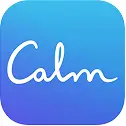
Calm

Headspace

Mindly

Warry Watch
Pros
- High-quality user experience and onboarding
- Cross-platform availability (iOS, Android, Web)
- Strong brand identity and emotional design
- Clear positioning for different user needs (sleep, meditation, anxiety tracking, mind mapping)
- Simple navigation and intuitive user flow
Cons
- Limited free content; most value behind paywall
- Lack of guided content in niche apps (e.g. Worry Watch, Mindly)
- No social or community features
- Navigation not fully intuitive in some apps
- Limited personalization in smaller apps
My conclusions:
To stand out, our mental health app should combine emotional and personalized user experience with accessible, free-to-use core features. Unlike most competitors, we aim to offer a safe space with both self-care tools and peer connection, enable guided discovery through personalized recommendations, prioritize community-building and human-centered accessibility.
Ideation and finding solutions
- Sitemap
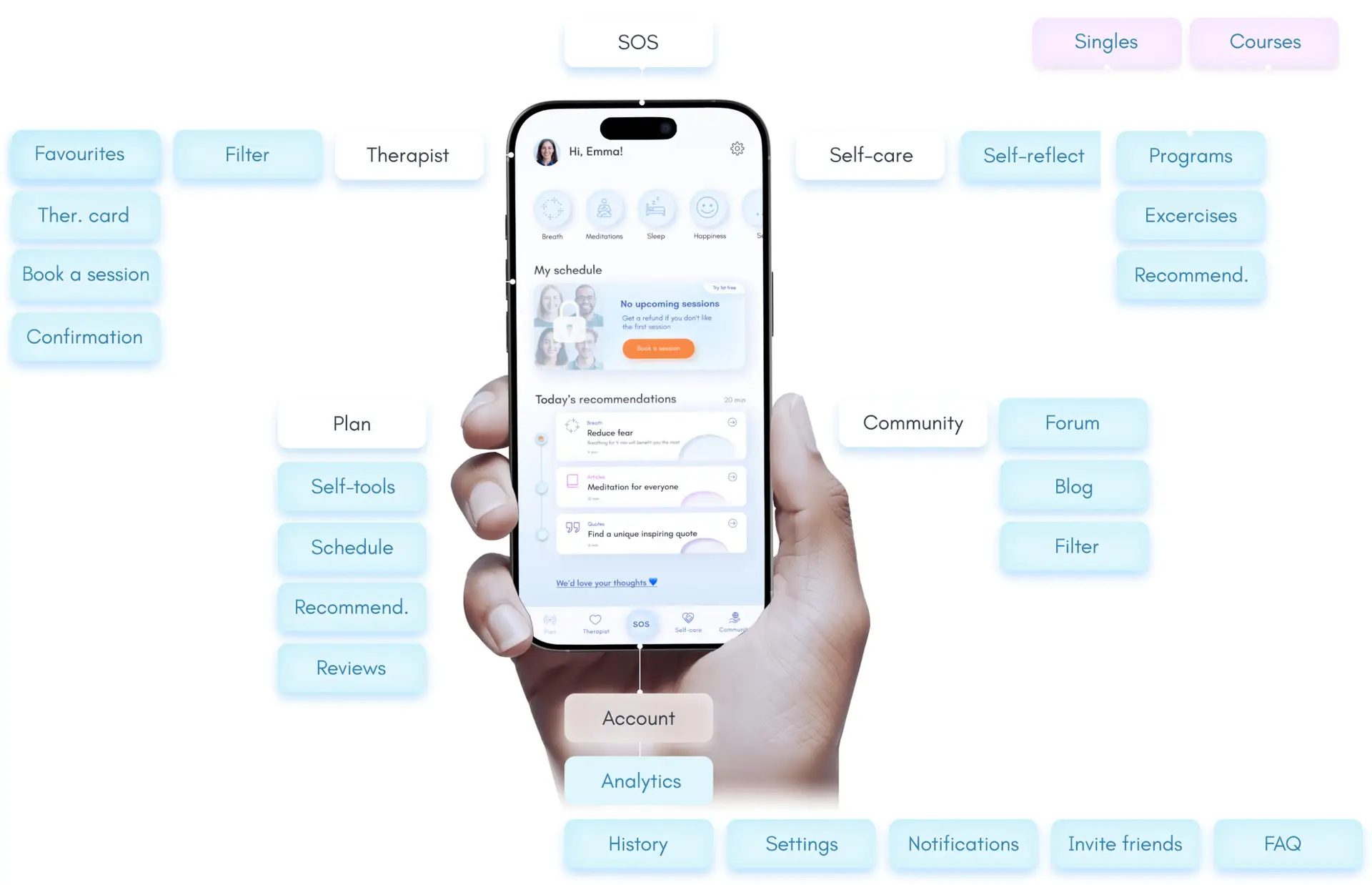
- Wireframes
To ensure a clear structure and user-friendly navigation, I created low-fidelity wireframes that outlined the app’s key screens and user flows. These wireframes helped validate functionality early in the process and guided the visual design phase.












- Visual
After weeks of research and design work, I am excited to share the final visual design of the app — built for support, self-education, and ease of use. It was also a design experiment with neomorphism that helped create a sense of lightness, calm, and emotional relief after a hard day using the app.
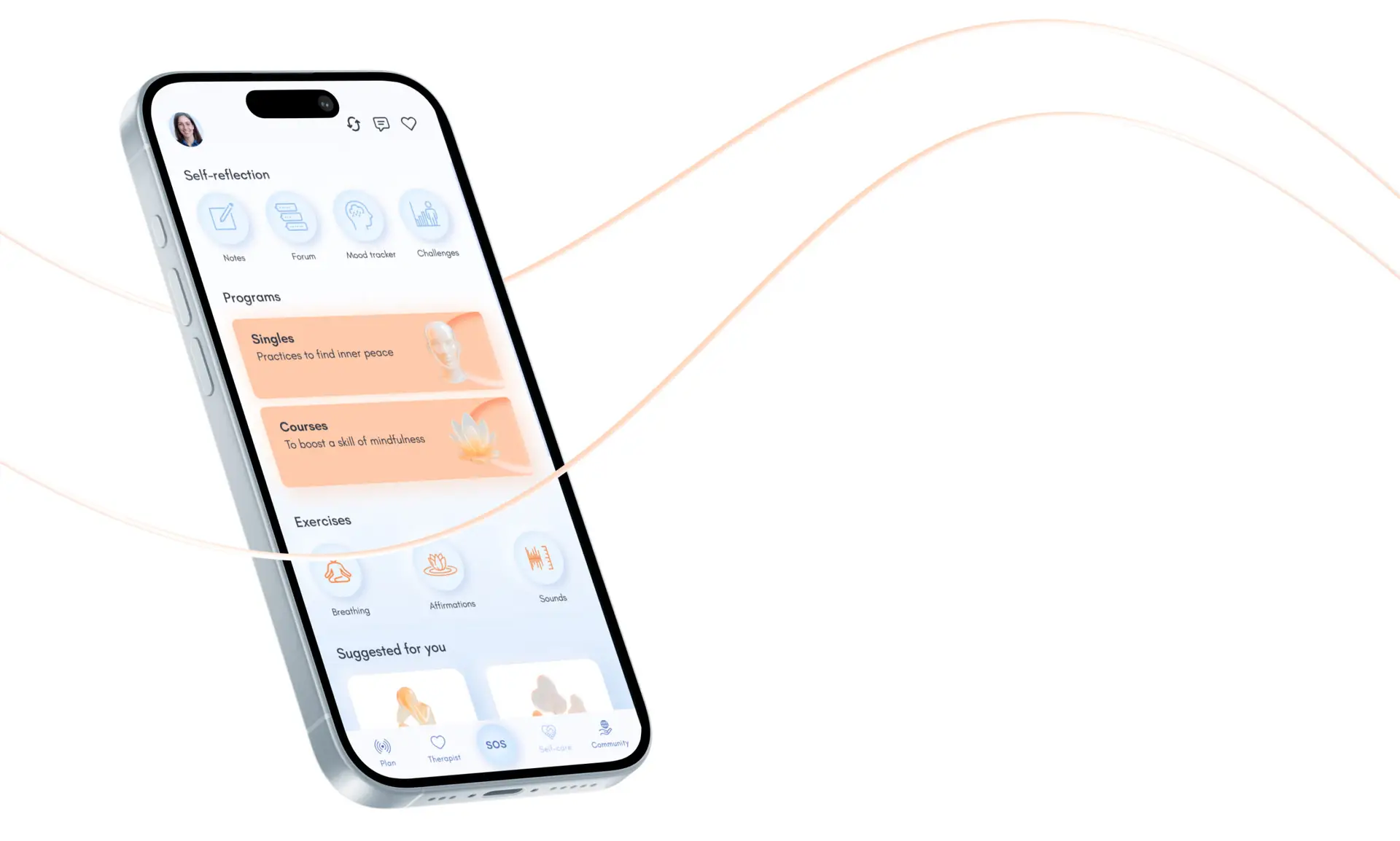
Welcome to
inner app
– where there is nothing superfluous, except for the most important: the ability to evaluate your state, self-help, find your therapist, and also feel that you are not alone with your condition, read other people’s stories, share yours, communicate with like-minded people, and all this in one mobile app.
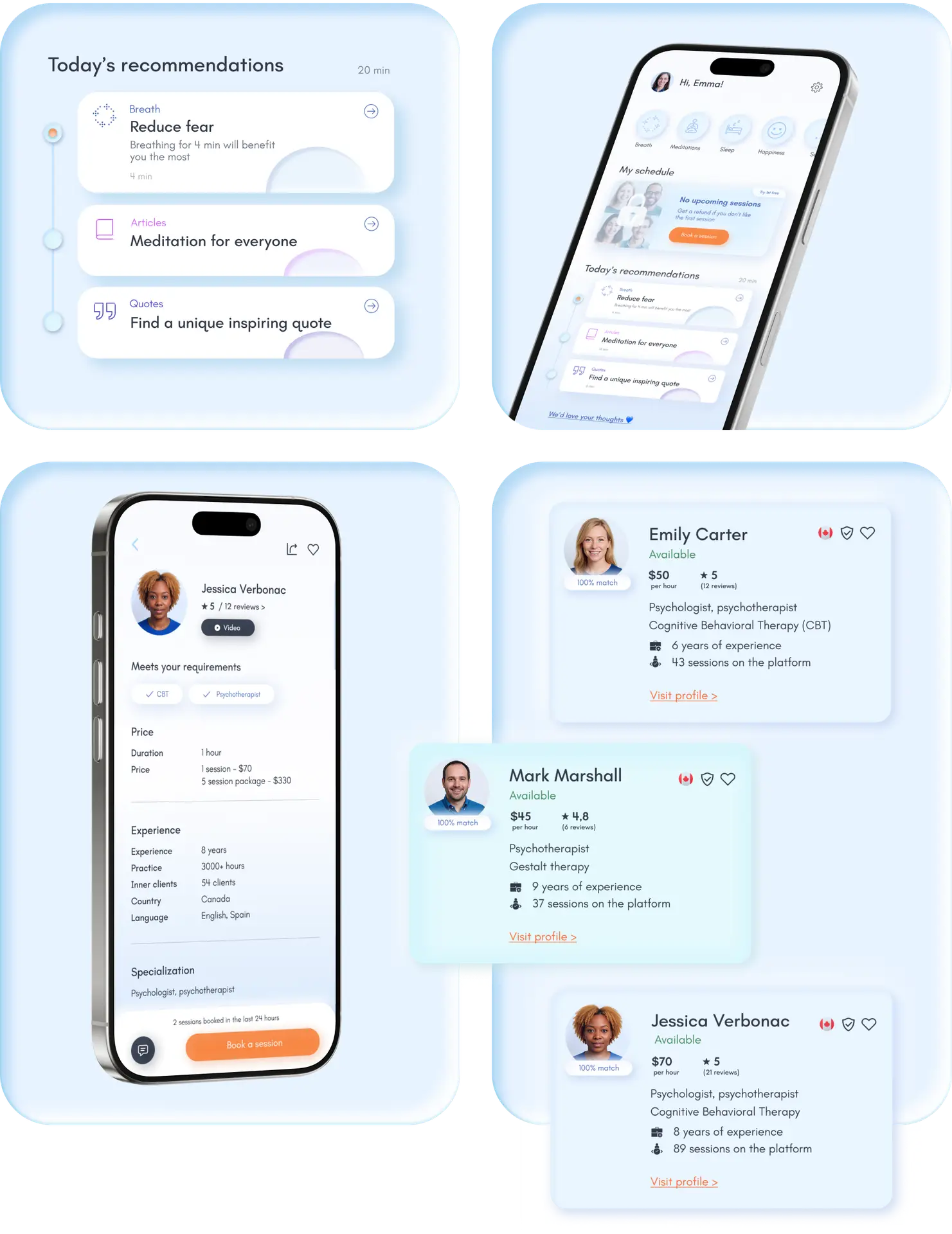
Moreover, if you are a non-profit person and have the opportunity to share professional experience, this application is a great platform for educating the population about psychological conditions.
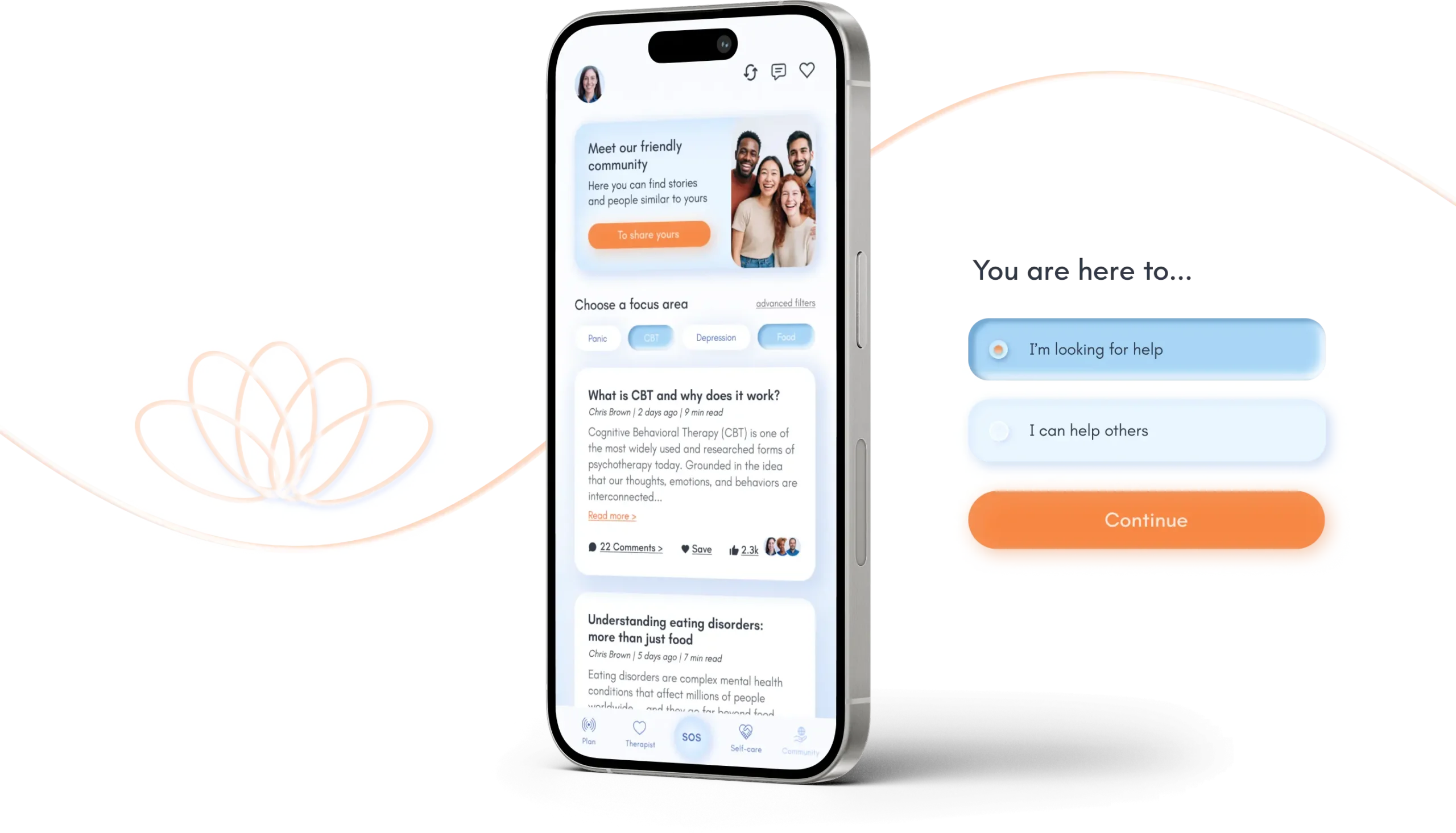
It is your AI - wellness companion in the pocket
- Built-in artificial intelligence allows you to communicate and get answers to all your concerns immediately.
- All it takes is the click of a button SOS
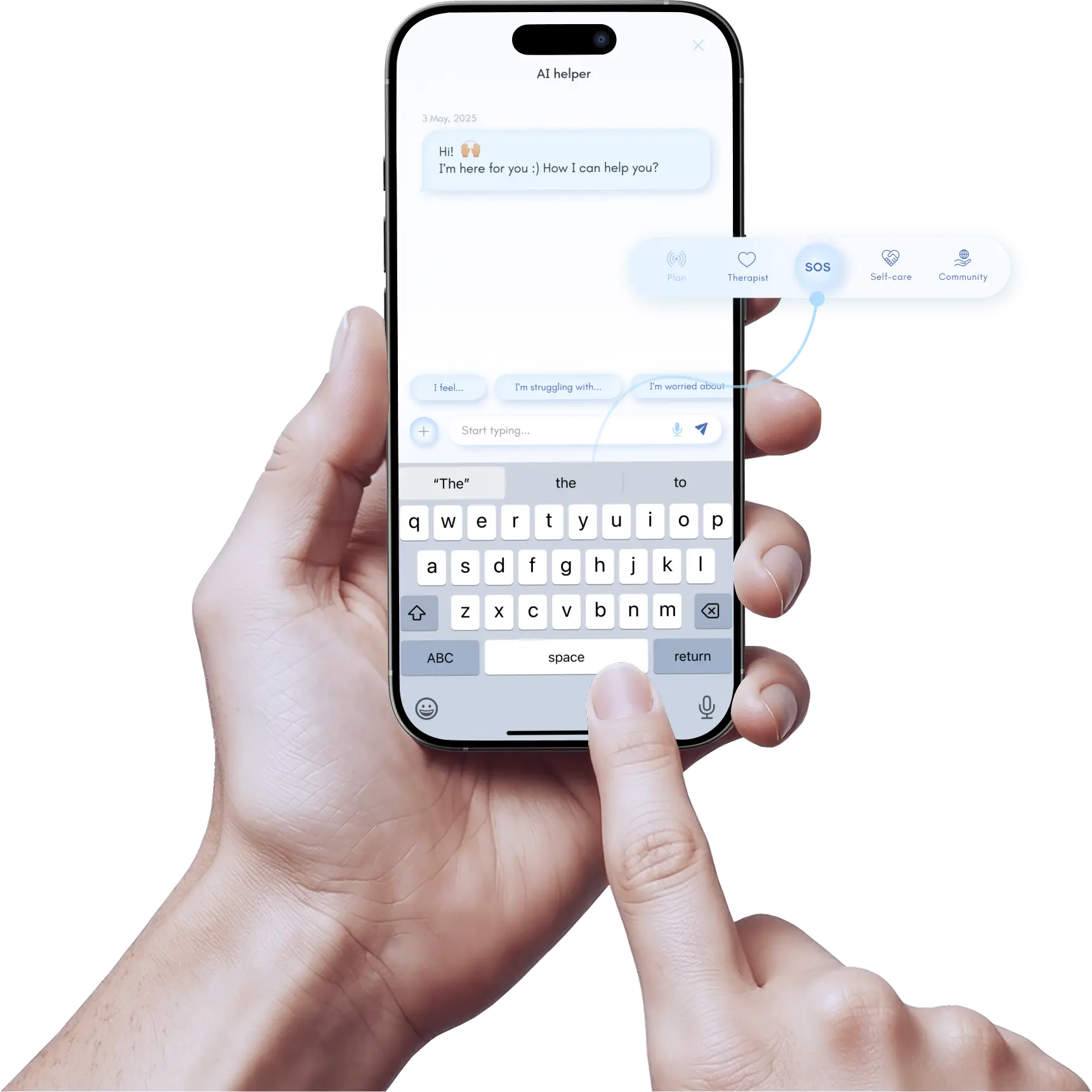
Results & Learnings
Through in-depth user research, interviews I identified key psychological barriers, emotional needs, and usability challenges people face when managing their mental well-being.
Key outcomes:
- → I validated a real user need for safe, private, and easy-to-use mental health tools.
- → Empathy maps and journey maps helped define pain points, including fear of judgment, lack of motivation, and overwhelming interfaces.
- → The prototype received positive feedback on clarity, warmth of UI, and emotional comfort it provides.
Final takeaways:
- → Users seek empathy-driven, low-barrier solutions that don’t feel clinical or overwhelming.
- → Emotional safety, personalization, and community support are crucial for long-term engagement.
- → A successful mental health app needs to balance simplicity, scientific credibility, and emotional design.
Opportunities for improvement
01. Better long-term engagement
Introduce guided journeys or weekly paths to keep users committed over time.
02. Mood-adaptive UI
Interface could adjust visuals, tone, or guidance depending on user’s current emotional state (e.g., calmer colors or simplified flow when anxious).
03. Offline therapist Q&A section
Provide access to pre-recorded answers to frequently asked questions from certified therapists.
...and finally, a little more visual!
